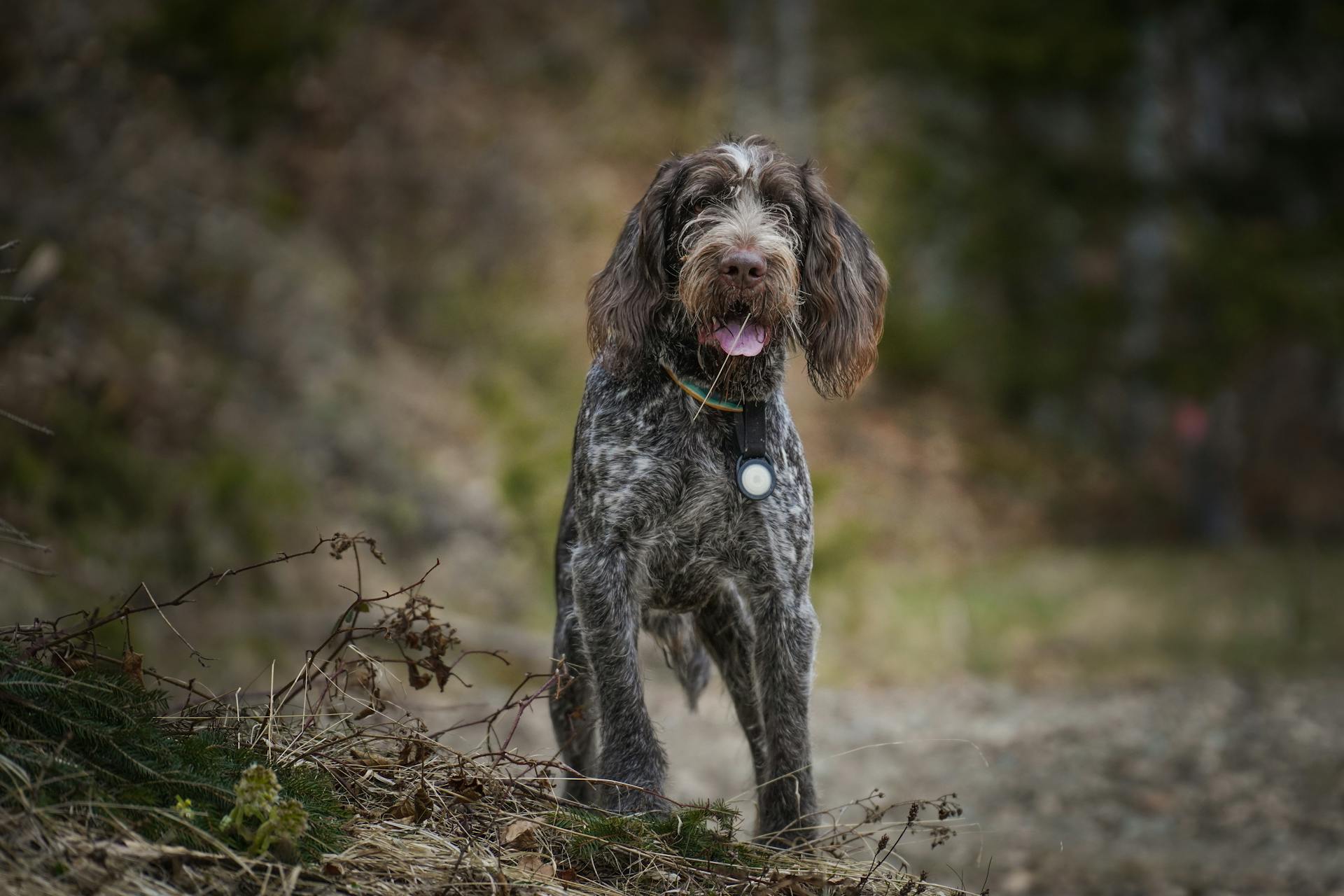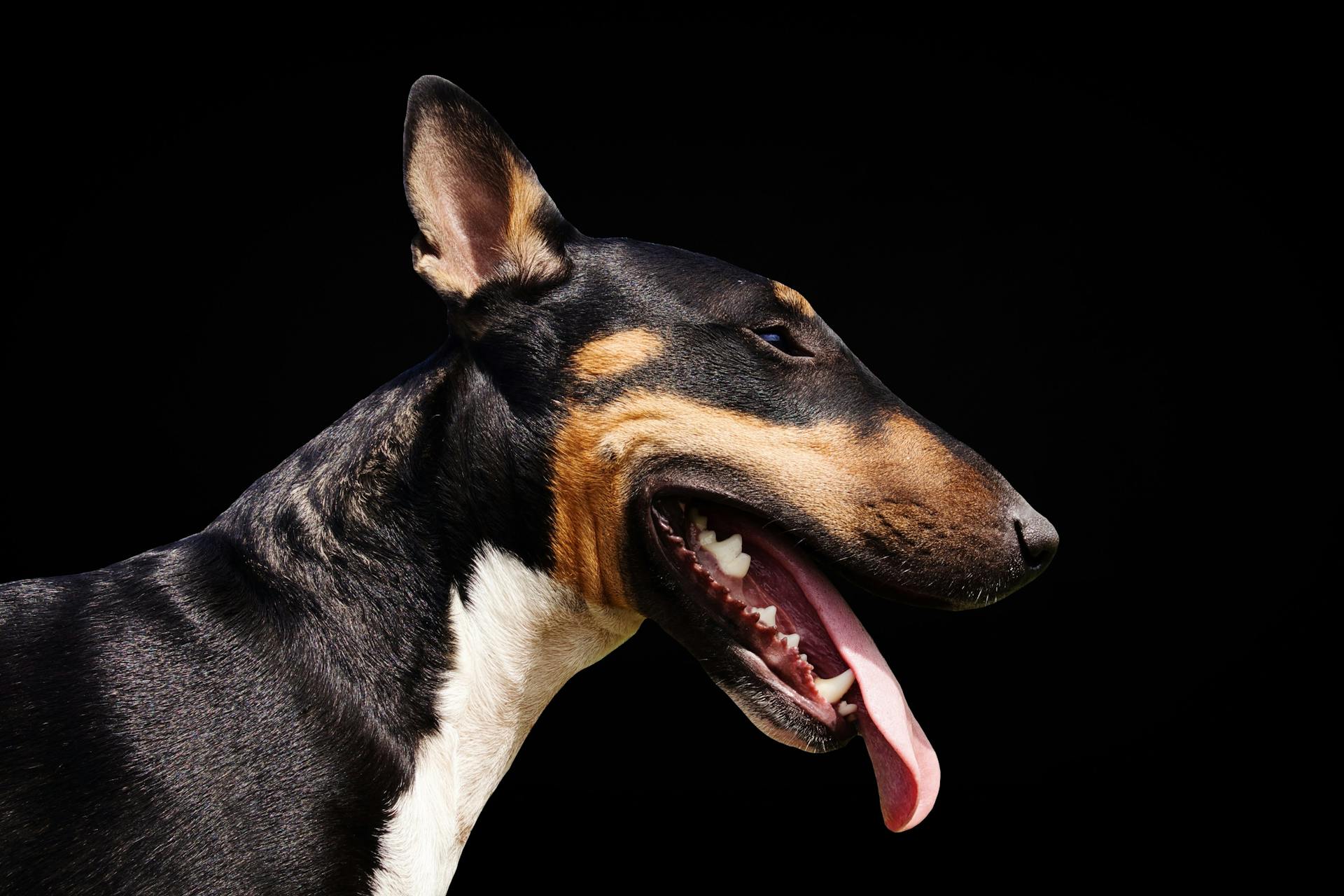
The dog respiratory system is a complex network of organs that work together to bring oxygen into the body and remove carbon dioxide. It's made up of the trachea, bronchi, and lungs.
The trachea, or windpipe, is a tube that connects the nose and mouth to the lungs. It's lined with cilia and mucus to help filter out dust and debris.
Dogs have a unique respiratory system that allows them to take in large amounts of oxygen with each breath. This is because of their large lungs and efficient gas exchange system.
You might enjoy: Canine Trachea Anatomy
Diagnostic Approach
To determine the cause of respiratory distress in your dog, consider their signalment and history as well as the broad anatomic differential diagnoses of dyspnea.
Once your dog is stable, you can pursue diagnostic tests such as blood analysis, imaging, and respiratory fluid analysis.
Upper airway examination is a crucial step in diagnosing respiratory issues. This examination involves preoxygenation under sedation and inspection of the oropharynx and larynx with a laryngoscope.
Recommended read: Respiratory Allergies in Dogs
To evaluate laryngeal function, minimize the level of anesthesia to preserve laryngeal function as best as possible. Consider using doxapram HCl to stimulate laryngeal motion.
Cervical and thoracic radiographs are useful for detecting masses and collapse in the larynx or trachea. Fluoroscopy can detect dynamic upper airway collapse that may not be visible on standard radiographs.
Diagnostic tests may involve:
- Blood analysis: Screening blood tests, blood gases
- Imaging: Thoracic ultrasound, thoracic radiographs, thoracic computed tomography (CT), or echocardiography
- Respiratory fluid analysis: Bronchoalveolar lavage, thoracocentesis
- Airway examination: Upper airway examination, tracheobronchoscopy
- Drug trials: Such as bronchodilators, diuretics, and corticosteroids.
Disease Categories and Etiology
Dogs can be classified into 8 disease categories related to respiratory distress, with distinct breathing patterns observed during physical examination.
These categories include primary respiratory diseases and secondary causes of respiratory difficulty, and the diagnostic approach is determined by the category of disease causing respiratory distress.
Some common causes of upper airway obstruction in dogs include naso-oropharyngeal disorders, such as polyps, especially in cats, but also in dogs, masses, and foreign bodies.
Severe head trauma can also cause upper airway obstruction, resulting in bone fractures, hemorrhage, and swelling in the nasal, jaw, and palatine areas.
A list of specific causes of upper airway obstruction in dogs includes:
- Naso-oropharyngeal disorders, including polyps, masses, and foreign bodies
- Severe head trauma that results in bone fractures and associated hemorrhage and swelling
- Laryngeal disorders, including laryngeal paralysis, laryngeal collapse, and laryngeal masses
- Tracheal diseases, including tracheal collapse, tracheal foreign body, and tracheal stenosis
- Brachycephalic airway disease, which involves a combination of primary and secondary anatomic abnormalities
Categories of Disease
Disease categories play a crucial role in determining the diagnostic approach for respiratory distress in dogs and cats.
There are 8 disease categories, which can be classified into primary respiratory diseases and secondary causes of respiratory difficulty.
These categories are associated with distinct breathing patterns observed during physical examination.
The diagnostic approach is determined by the category of disease causing respiratory distress.
Dogs and cats can be classified into these categories based on their symptoms and physical examination results.
The categories are a key factor in determining the best course of treatment for respiratory distress in pets.
Etiology
Upper airway obstruction can be caused by a variety of factors, including naso-oropharyngeal disorders like polyps in cats. These polyps can cause significant obstruction, especially if they're large.
Nasal, jaw, and palatine fractures from severe head trauma can also lead to upper airway obstruction. The resulting bone fractures can cause hemorrhage and swelling, further constricting the airway.

Laryngeal disorders, such as laryngeal paralysis, laryngeal collapse, and laryngeal masses, can also obstruct the airway. Laryngeal masses can be caused by neoplasia, abscesses, granulomas, or inflammation.
Tracheal diseases, including tracheal collapse, tracheal foreign body, tracheal stenosis, stricture, tracheal tear, or tracheal mass, can also cause upper airway obstruction. These conditions can be life-threatening if left untreated.
Some breeds, such as the English bulldog, are prone to brachycephalic airway disease. This condition involves a combination of primary and secondary anatomic abnormalities of the upper airways, including stenotic nares, an elongated soft palate, and laryngeal edema and/or collapse.
Diagnostic Tests and Approach
Diagnostic tests for the dog respiratory system should be approached with caution and only performed once the patient has been stabilized as much as possible.
A brief physical examination is essential before proceeding with diagnostic tests.
Blood analysis, including screening blood tests and blood gases, can provide valuable information about the patient's condition.
Imaging tests, such as thoracic ultrasound, including focused assessment with sonography for trauma, triage, and tracking (tFAST), thoracic radiographs, thoracic computed tomography (CT), or echocardiography, can help identify the location and severity of the disease.
Respiratory fluid analysis, including bronchoalveolar lavage and thoracocentesis, can provide a sample of the fluid in the lungs or chest cavity for examination.
A list of diagnostic tests for the dog respiratory system includes:
- Blood analysis: Screening blood tests, blood gases
- Imaging: Thoracic ultrasound, thoracic radiographs, thoracic computed tomography (CT), or echocardiography
- Respiratory fluid analysis: Bronchoalveolar lavage, thoracocentesis
- Airway examination: Upper airway examination, tracheobronchoscopy
- Drug trials: Such as bronchodilators, diuretics, and corticosteroids
For an upper airway examination, it's essential to minimize the level of anesthesia to preserve laryngeal function.
Carefully observing inspiration versus expiration can help ensure that the larynx is abducting (increasing the aperture of the rima glottis) on inspiration.
Specific Canine Diseases
Kennel cough is a common canine disease that affects the respiratory system, often caused by the Bordetella bronchiseptica bacteria.
This highly contagious disease can spread quickly in areas where dogs are in close proximity to each other, such as dog parks or kennels.
Chronic bronchitis is another condition that can affect dogs, causing inflammation and scarring in the airways, which can lead to coughing and difficulty breathing.
Kennel cough can be treated with antibiotics and supportive care, but chronic bronchitis often requires ongoing management with medication and lifestyle changes.
What We Know About Canine Unidentified Illness
The canine unidentified illness, also known as atypical canine respiratory disease, is a mysterious condition that's been reported in multiple states, with a higher concentration on the West Coast of the U.S.
The main symptom associated with this disease is coughing, but it's essential to note that a cough can also be a sign of other common dog illnesses, like kennel cough.
Veterinarians are trying to establish a case definition to identify which cases may be specific to this unusual pattern, by collecting samples from dogs presenting symptoms and sending them to a lab for testing.
The cases that are most concerning are the ones that progress to pneumonia and other severe outcomes, and test negative for known pathogens.
It's going to take some time to gather enough samples and do further testing to answer questions about the origin, causes, and whether this is a new or recurring issue.
Specific Diseases
Feline asthma and chronic bronchitis in dogs and cats can cause lower airway obstruction, resulting in expiratory distress and a wheeze on thoracic auscultation.
Chronic bronchitis in dogs can lead to bronchomalacia, a condition that causes lower airway obstruction.
Bronchodilator therapy often results in rapid improvement in patients with lower airway disease, typically within 5-15 minutes.
Treatment of lower airway disease may involve bronchodilators, corticosteroids, and deworming in cats.
Oxygen supplementation is also a crucial part of initial stabilization and therapy for lower airway disease.
Expand your knowledge: Are Therapy Dogs Service Dogs
Canine Structure
The canine respiratory tract is a complex system that's essential for our furry friends' survival. The nose is the most forward portion of the respiratory tract, and it's made up of a fixed bony case and a moveable cartilage framework.
The nostrils, or nares, are the entrance openings of the nasal cavity and are supported by cartilage. They're located on the front portion of the nose, which is flattened and hairless.
The pharynx, or throat, is a fairly large round cavity that's lined by soft membranes. It has two parts: the nasopharynx, which is associated with the respiratory tract, and the oropharynx, which is associated with the digestive tract.
Related reading: Canine Nose Anatomy
The larynx, or voice box, is a round structure that's composed of muscles, cartilages, and soft tissues. Its cartilages are designed to open and close during breathing or swallowing.
The trachea, or windpipe, is a semi-rigid, flexible tube that connects the larynx to the bronchi of the lungs. It's made up of many C-shaped cartilages that are strung together.
Here's a breakdown of the main components of the trachea:
- C-shaped cartilages
- Elastic ligaments
- Muscles
The bronchial tree within the lungs begins at the bifurcation of the trachea with the formation of a right and a left mainstem bronchus. Each mainstem bronchus divides into lobar bronchi that supply the various lobes of the lung.
Frequently Asked Questions
How can I help my dog with respiratory problems?
Help your dog with respiratory problems by keeping them calm and cool, and creating a quiet, comfortable space for rest
What happens when a dog is in respiratory distress?
When a dog is in respiratory distress, its lungs become inflamed and leak fluid, making it hard for oxygen to reach the body's vital organs
What are the symptoms of a lower respiratory infection in a dog?
Symptoms of a lower respiratory infection in a dog include coughing, rapid breathing, difficulty breathing, and fatigue during exercise. If you suspect your dog is experiencing these symptoms, seek veterinary care immediately.
Sources
- https://publichealth.jhu.edu/2023/understanding-atypical-canine-respiratory-disease
- https://todaysveterinarypractice.com/respiratory-medicine/approach-to-respiratory-distress-in-dogs-and-cats/
- https://www.merckvetmanual.com/respiratory-system/respiratory-system-introduction/the-respiratory-system-in-animals
- https://easy-anatomy.com/anatomy-of-the-canine-respiratory-system/
- https://www.petplace.com/article/dogs/pet-health/structure-and-function-of-the-respiratory-tract-in-dogs
Featured Images: pexels.com


